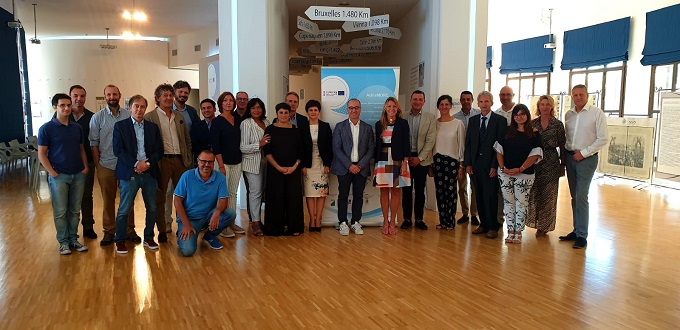Software developments, models implementation, testing on relevant case studies and sophisticated instruments acquisition have been carried out, in order to capitalize the 2007-2013 IPA Adriatic CBC programme-funded project ADRIARadNet. The latter developed a decision support system (DSS) to observe and forecast possible scenarios at high hydro-meteorological risk for civil protection purposes.

AdriaMORE integrated system developed new DSS components, more in detail:
- a weather radar composite software capable of ingesting and processing data from systems with different features was developed and its assessment was conducted on case studies by utilizing Italian and Croatian radar data. A web interface is available at http://radar.aquila.infn.it/network/ where the instantaneous rainfall estimates for the Croatian and Italian composites are displayed in real-time;
- a new version of the hydological model (CHyM), to be used operationally for coastal flood prediction on the Pescara and Neretva river basins was designed. The new specific parameterization was calibrated and tested over the two catchments through the simulation of relevant case studies, characterized by intense winds and sea level rise. The CHyM model can read sea level measurements in input to modify the friction of the river flow in the river outlet, thus enhancing the coastal flood prediction capability;
- an air-sea coupled prediction system was built on the Adriatic area, which was previously tested on two case studies, one for the Abruzzo Region and one for Croatia, and is now working in operational mode on the website http://oceanlab.univpm.it/, enabling to forecast the most important meteorological and marine variables such as the 3h accumulated precipitation, the 2m air temperature, the 10m wind, the sea level and wave height. A procedure that "ingests" surface and radio sounding data available on the area covered by the domain - by means of the so-called 3D-Var variational assimilation technique - was also developed within the system;
- a satellite data processing procedure to evaluate environmental bio-chemical indicators of coastal seawaters in the Adriatic Sea, like total suspended matter (TSM) and chlorophyll content (CHL) was performed. These indicators provided information about coastline morphology (erosion-sedimentation dynamical balance) and eutrophication trends of the marine coastal ecosystem;
- numerical model simulations of transport and dispersion in the Adriatic Sea basin were furtherly developed. Established modelling software was set up, in order to simulate Lagrangian trajectories on the sea surface. Large-scale circulation fields are provided by INGV – Italy’s National Institute of Geophysical and Volcanology - whereas an innovative Lagrangian model for the unresolved sub-grid scale motions, developed by CNR ISMAR, takes into account small-scale turbulent dispersion. As far as coastal flow modelling is concerned, a 3D high-resolution hydrodynamical model was implemented and set up for upcoming applications to the pilot studies e.g. the Pescara river interaction with the harbour area in the last project phase;
Moreover, the Dubrovnik area is the site chosen for installing the wind profiler and the related infrastructure work are now completed. The first operational tests were performed, the profiler will be used to improve wind monitoring and forecast. A firefighting boat was procured, which is now moored in Dubrovnik. The vessel is used for firefighting operations and is tasked with the monitoring of the southernmost part of the Adriatic that is difficult to be reached overland. Because of its size, it would also be suitable for interventions in case of pollution, not only for the installation of floating dams, but also for quick interventions by chemical means in the event of minor pollution of the sea surface.
Furthermore, the initial activities for the integration in the DSS platform of the new developed components were carried out, in particular the new types of data and applications to be integrated were defined and their conformity to the structure of the DSS management system was assessed. Finally, the methodology for carrying out the upcoming measurement campaigns in Italy and Croatia, where the entire new system will be tested, was discussed, in particular a work group was established who drew up a list of available models.
AdriaMORE objectives have been fully achieved: The territories and people are equipped with effective tools to tackle severe weather events and other marine risks triggered by hydrometereological events, thus reducing damage and increasing safety.


